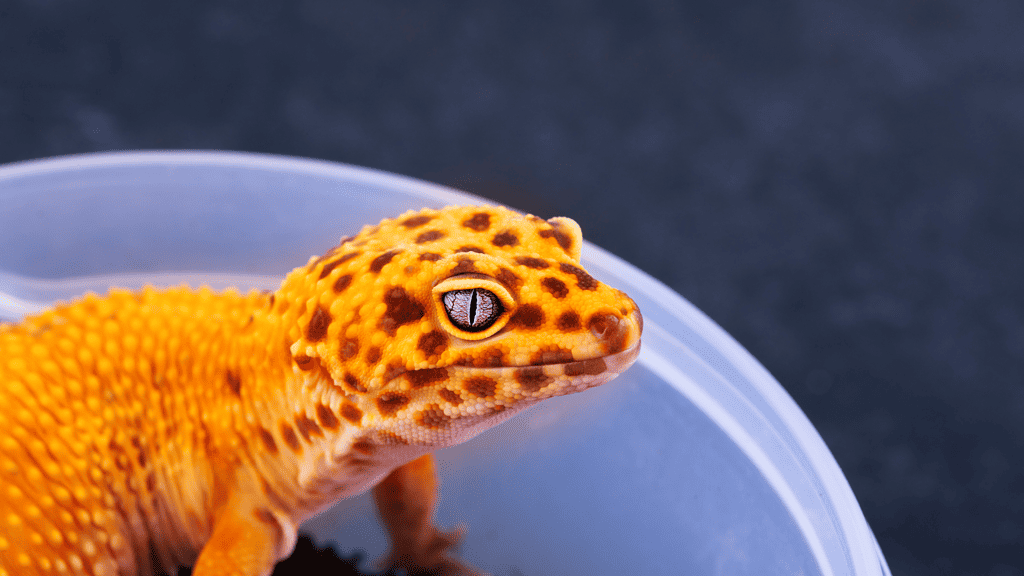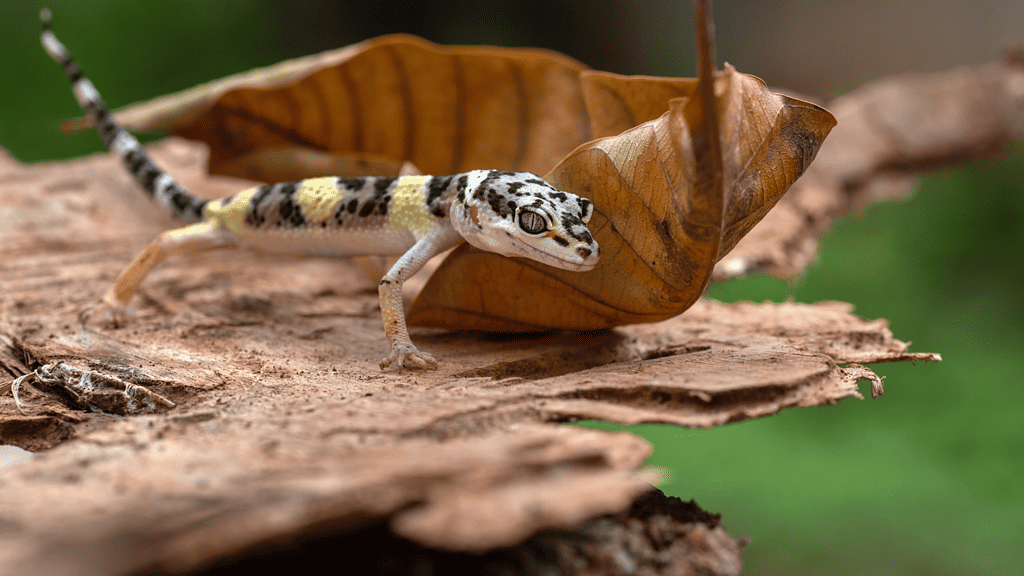The leopard gecko is among the most common types of pet lizards due to its hardiness, friendliness, and full of character. But are leopard geckos fall in the category of exotic pets?

There is no doubt that the leopard gecko is among the most well-liked exotic pets. This fascinating saurian has the ability to vocalize, as well as lick its eyes and “wink” its ears! They are available in a bewildering variety of colors and designs, and their prices change depending on the degree to which they are rare. Providing a leopard gecko with suitable housing and food is not difficult.
Habitat of exotic leopard geckos
The leopard gecko is a type of desert lizard native to the arid regions of Asia, Pakistan, and northeast India. Over the course of the past three decades, the species has emerged as a widely kept pet around the globe. In the wild, leopard gecko lifespans range from 7 to 10 years, although they can live up to 20 years in confinement.
Description
These lizards are just 2 to 3 inches long when they are hatchlings, but they grow to be 9-11 inches long when they are adults. Leopard geckos are the perfect pet for many apartment dwellers because of their tiny size and aesthetically appealing yellow and white coloring with black dots (usually, but juvenile geckos may be more patterned). The skin on their back is rough all the way from the nose to the tip of the tail, but the skin on the belly is shockingly smooth and almost see-through. This species can autotomize, sometimes known as “losing its tail,” to divert the attention of possible predators. “Dropped” tails will eventually grow again, but the arrangement may not match perfectly, and the texture will not be rough as it was before.
Enclosure
Leos may be kept with little effort in glass aquariums holding 15–20 gallons of water or in other containers of comparable size. It is possible to house two geckos in an enclosure of 15 gallons provided that either both geckos are female or one of the geckos is male. Fights between two males will take their toll on both of them. Three geckos may live contentedly in a tank with a capacity of 20 gallons. The ideal number of females to males is two to one.
Other possibilities for enclosures include containers designed in the manner of sweater boxes, which may be customized with regard to factors such as airflow, lighting, and heating. Rack systems may be bought or made, and they are used to store geckos by certain breeders and keepers of bigger collections. These racks can be bought or made. It is important to remember that leopard geckos are primarily terrestrial in their habitat and have a limited capacity to climb; therefore, this factor must be considered while designing their enclosure.
Cage Accessories
Live potted plants that remain relatively tiny, such as different grasses and bromeliads, can be used to design a naturalistic terrarium for Leos. This terrarium can be used to house the geckos. It is possible to use fake plants without risk, which will have the same impact as natural plants. If a reptile accidentally eats some of the plant or the soil, any potted plants must be herbicide and pesticide-free at all times. Plants make the enclosure more aesthetically beautiful for the owners and provide enrichment and a sense of security for the geckos that live inside. It would be preferable to provide as many shrubs and greenery as is humanly possible.
At least two different sites inside the enclosure should have hides installed. Some examples of suitable hides include tiny cork logs, rock caves (but not heat caves), and other creative hiding. As a matter of preference, one hiding spot ought to be offered on the warmer end, and another ought to be provided on the cooler end in order to encourage thermoregulation while placing as little stress as possible on the animal.
In order to enhance the environment and provide a place for the Leo to sun itself, the cage should be augmented with branches, bark, and a few tiny pebbles. Geckos are often seen in their native habitats scurrying around the rocky edges of grassy areas. Crepuscular in their activity, leopard geckos will occasionally bask when the opportunity presents itself.
Feeding
The Leopard gecko is a real insectivore that feeds on insects as small as roaches (including dubias), silkworms, bloodworms, crickets, and red worms. When it comes to feeding geckos, one good rule of thumb is that the food item supplied should always be alive and should not be any bigger than 1/2 the size of the gecko’s head. Adult geckos should be given about as much food as they can consume in a period of ten minutes every other day, while hatchlings and young geckos should be given between two and three different food items once a day.
Water
It is essential to provide a water bowl that is big enough for the gecko to submerge its body in the water completely. Because lizards frequently defecate in their water, the dish it is kept has to be cleaned at least once a week, and the water needs to be changed daily. It is advisable to immerse the animal in clean, warm water regularly in order to facilitate the shedding process.
Humidity
To avoid any problems, the humidity level in the enclosure for the leopard gecko should be maintained between 35 and 40 percent, and a humid hide box should be provided when the animal is shedding. Along with the water dish, keeping the humidity level may be accomplished by misting the area once or twice daily. This also provides essential hydration. There is a possibility that some will learn to sip from a water dish, while others will instead lick drops off of their skin and the furniture of their cage.
Temperature
Temperatures range from 79 to 85 degrees Fahrenheit during the day, with a basking zone that may reach 87 to 90 degrees. Temperatures can fall to as low as 71 degrees Fahrenheit at night, although it is recommended that they be kept between 73 and 75 degrees.

Since leopard geckos are native to arid environments, the question is: can you add sand to their enclosure?
Although leopard geckos make their homes in the sand in the wild, their way of life is much different than when they are in captivity. They are always moving about and looking for food, and because of this, they are able to excrete ingested sand grains much more quickly. They also consume a wide variety of foods. Leopard geckos kept as pets, on the other hand, are not as active and run the danger of impaction due to the ingestion of sand. This happens when the gastrointestinal system becomes obstructed, and the intestine cannot move the indigestible chemicals causing the blockage. On the bottom of the terrarium, a material that does not produce particles, such as tile or paper towels, is suggested by most vets.
When is the best time to bring your leopard gecko to the veterinarian?
As is the case with our warm-blooded exotic animals/pets, Leos should have an annual checkup with a veterinarian and annual fecal analysis because the insects they consume might cause them to take up intestinal parasites. Your veterinarian will be able to detect any growing concerns, such as a calcium deficit or restricted toes, through the use of annual checkups. If this is not the case, you should make an appointment with your veterinarian if you notice any changes in your pet’s feeding habits, temperament, or the amount or consistency of their feces.
